| Reviews & Columns |
|
Reviews DVD TV on DVD Blu-ray 4K UHD International DVDs In Theaters Reviews by Studio Video Games Features Collector Series DVDs Easter Egg Database Interviews DVD Talk Radio Feature Articles Columns Anime Talk DVD Savant Horror DVDs The M.O.D. Squad Art House HD Talk Silent DVD
|
DVD Talk Forum |
|
|
| Resources |
|
DVD Price Search Customer Service #'s RCE Info Links |
|
Columns
|
|
|
Bonanza: The Official First Season, Volume 1
Bonanza, the single most successful television series of the 1960s (and second only to Gunsmoke for network TV's longest-running Western, at thirteen and a half seasons), celebrates its 50th anniversary today by premiering on DVD for the first time in a fully authorized season release: Bonanza: The Official First Season, Volume 1 (I'll be reviewing Volume 2 later this week). Certainly one of the most beloved TV series of the boomer generation, this iconic, epic-scaled Western - the first weekly Western ever to be televised in color - starred household names Lorne Greene as the patriarch of the Cartwright family, and Michael Landon, Pernell Roberts, and massive Dan Blocker as his intriguingly mismatched sons. Telling the story of the powerful Cartwright clan and their fabulous thousand-square mile Nevada timber and cattle ranch, the fabled Ponderosa, Bonanza may not have been an originator in concept or design like Gunsmoke or Frontier or The Life and Legend of Wyatt Earp, but it did continue TV's late-50s trend towards more adult-oriented western drama, with solid, challenging scripts put over by the charismatic central cast and veteran supporting players, while providing a splash of big-screen allure with all those spectacular California backdrops filmed in saturated color. And most importantly for viewers today, it plays just as well as it did 50 years ago. Solid bonuses for the fans bolster this clean DVD presentation from Paramount.
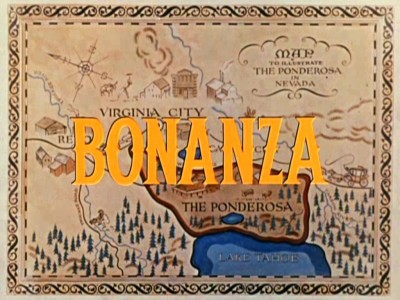
It's the late 1850s, and gold and silver fever are sweeping through the hills and valleys of the celebrated Comstock Load. Virginia City, Nevada, sitting right on top of those millions of dollars' worth of ore, is bustling with miners, settlers, businessmen, rustlers, con artists, and killers. And butting right up against Virginia City is the massive Ponderosa ranch, a thousand-square mile New World Eden filled to the brim with pine and beef. Overseeing this operation is voice-of-God Ben Cartwright (Lorne Greene), the thrice-widowed land baron who watches over his spread as fiercely - and as tenderly - as he does his three grown sons. Eldest, Adam Cartwright (Pernell Roberts), is the most serious of the three siblings, and the one who works most directly under Ben in running the Ponderosa. His mother the daughter of a New England sea captain, Adam was schooled back East as an architect and engineer. Middle son Eric "Hoss" Cartwright (Dan Blocker) gets his massive physique from his mother, a six-foot tall Swede who could punch like a mule. Hoss, who may seem rather dim or naïve at times when he's not killing a bear with only his hands, or knocking down a tree, is in reality quite sensitive to his surroundings, and to the sufferings of others. Finally, Little Joe Cartwright (Michael Landon), the youngest son, gets his smoldering dark looks and equally tempestuous nature from his beautiful half-Creole mother, whom Ben met during a trip to New Orleans' French Quarter. Little Joe is certainly the most reckless of the clan, relying on his charm and his fast fists to both get him into trouble, and out of it again...especially if there's a lady involved. Constantly patrolling their land to keep opportunists at bay, the Cartwrights inevitably get involved week after week in the troubles of others, who look to the Cartwrights as one of the few stabilizing forces in the wild and wooly excesses of the Old West.
Evolving out of writer/producer David Dortort's (The Lusty Men, Clash by Night) earlier Western anthology drama for NBC, The Restless Gun, Bonanza premiered at a time on the Big Three's network schedule (1959) where the top three-rated shows were Westerns (Gunsmoke, Wagon Train, and Have Gun Will Travel), with eight other Westerns rounding out the Nielsen Top Thirty. In such a competitive climate for adult Western drama, Bonanza needed some kind of unique draw to get it noticed, so it was decided by the network to film and broadcast the series in full color - the first Western series to do so. While this decision certainly garnered press for Bonanza, the network's move to color wasn't predicated solely on shoring up a new western series. More importantly, this shift away from black and white programming was the next step in a long-range plan to sell more RCA color televisions. Having beaten out CBS, which gave up color broadcasting earlier in the decade when it proved too expensive due to the lack of compatible color sets in the viewing audience, RCA's improved color technology (its method of color transmission could be picked up on black and white sets, too) allowed NBC to aggressively market color broadcasts in the service of selling parent company RCA's color sets, and a big-scale Western - the most popular genre on the tube during this period - was deemed the ideal vehicle to showcase RCA's improved color transmission.
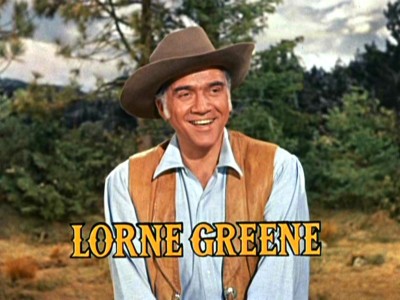
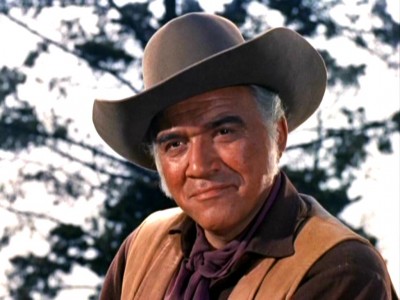
But color couldn't beat the black and white legal maneuverings of Perry Mason - at least not at first (less than 3% of all households even had a color set at this point). Going up against the 10th rated Perry Mason on Saturday nights at 7:30pm, Bonanza was initially creamed in its first season ratings, with a full CBS Saturday night line-up that included heavyweights Gunsmoke, Have Gun, Will Travel, and Wanted: Dead or Alive, proving too tempting for viewers to switch over to the Cartwrights. Cancellation was considered for the expensive misfire, but contrary to what most history books on the subject say, Bonanza eventually garnered a not-insignificant audience in that same time slot by the end of its sophomore season, climbing all the way to 17th for the 1960-1961 season, right behind falling 16th-rated Perry Mason. It's true that Bonanza's ratings climbed even higher once it was moved to Sunday nights during its third season, but that time slot in and of itself wasn't the factor (the former occupant, Dinah Shore, never cracked the Top Twenty with her mid-level performing Chevy Show) - Bonanza was fast-gaining momentum all on its own - color or not - before settling in for its phenomenally successful 11-year run on Sunday nights.
And it's easy to see why: it's a hell of an entertaining show. From that driving, jangly Jay Livingston and Ray Evans theme song, to the highly stylized opening credits, where the Ponderosa map burns to allow the Cartwrights to seemly ride right through, Bonanza sure doesn't seem like a freshman series tentatively feeling its way along its form and content. It feels muscular and sure of itself and confident, right from the very first episode, and in that confidence comes a comfortableness - no doubt emphasized also by episodes that deal with complex themes in the history of the American West in terms that fit easily within a one hour dramatic anthology format. And "comfortableness" as an aesthetic goal was paramount to Big Three network offerings in 1959...even if a show dealt with serious adult issues as did Bonanza (networks understood then - as they've forgotten now - that their series' first goal should be to entertain the audience). As with other Westerns on the network schedules that year, Bonanza does a neat trick of balancing straight dramatic concerns with the action conventions of the genre, giving something for everyone who might be tuning in (also a hallmark of network programming at that time). And indeed, the anthology format that Bonanza adopted from other TV Westerns serves to accentuate that smorgasbord approach for viewers: one week an episode of Bonanza might feature a serious story involving the exploitation of miners by callous businessmen (The Philip Deidesheimer Story); the next week, a humorous take on an Irish lass who hornswaggles her way into a fortune (The Saga of Annie O'Toole), with the following week showcasing an action-packed High Noon-ish take-off (Vendetta). Add to that the appeal of an ever-rotating roster of guest stars, as well as the main cast alternating center stage from episode to episode (even the opening credits reflect this, as each star gets to "headline" the series every fourth episode), and you have a series that's form allows for a wide range of dramatic and humorous stories, while always staying fresh for viewers.
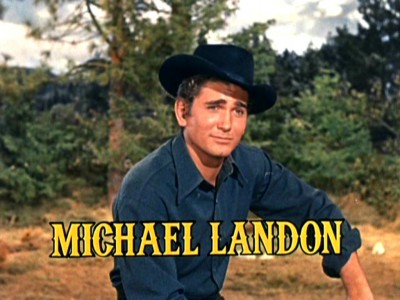
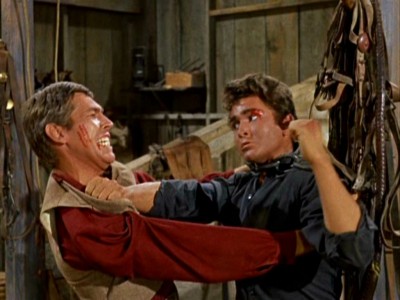
Bonanza goes one step further with this concept by having the brothers come from different mothers (who are all conveniently deceased), allowing these three characters to share seemingly nothing from their father except a loyalty to the family name and of course, to the Ponderosa (many jokes were made at the time about the improbability of Lorne Green fathering these adult men). Cleverly, the Cartwrights not only represent huge geographical swaths of potential TV viewers (Adam = East Coast, Little Joe = the South, Ben = the West, and Hoss' Swedish background taking care of the Northern states, with all of their declared regional differences smoothed off enough to satisfy the great expanses of the Midwest), they also stand in for clearly established male fantasy figures for both men and women (something The Big Valley borrowed later). If a businessman watching Bonanza fancied himself the tycoon of his small appliance shop, or a harried father sitting down in front of the TV looked on approvingly at Cartwright clan, then patriarch Ben was an ideal - and idealized - figure. And if those men's wives happen to sit down to watch, as well, they might allow themselves to dream of the hurried, impassioned, impetuous advances of youngster dreamboat Little Joe before they moved up to the darker, more sophisticated lovemaking techniques of coolly intelligent Adam. And of course, the kids sprawled out on the floor in front of the set didn't have to wait too long inbetween all the talking for someone to take a shot at someone else, or for Hoss to haul off and take someone's head off with a massive swipe of one of his ham-fists (gentle giant Hoss had to be the favorite Cartwright of the small-fry demo).
Bonanza also has an element of almost Biblical reverence for the land and for the process of working it and caring for it, that I haven't encountered yet in other Westerns from this period. In the opening scene of the first episode, A Rose for Lotta, Adam and Ben ride their horses to a bluff overlooking a stretch of pine and mountains, with Ben reverently intoning, "Look at it, Adam. Feast thine eyes on a site that approacheth Heaven," to which sensible, educated Adam replies, "You've been to a lot of places and you've seen a lot of things, Pa. But you've never seen or been to Heaven." Ben then responds, "Well, maybe I've never been to Heaven, and maybe I'm never going to get the chance...but Heaven is going to have to go some to beat the thousand-square miles of the Ponderosa." Combined with that veneration for the land, there's a strong conservationist message woven through many of the episodes that combines the Biblical theme of using the land for one's purpose as an expression of God's will, and preserving it for other generations to come. Ben loves the land of the Ponderosa, refusing to cut down one tree for a miner that doesn't meet his moral standards. In Death on Sun Mountain, Ben talks of the fools who upset the balance of nature by slaughtering the Indians' antelopes to sell at a premium to starving miners. Not only is he decrying the unnecessary waste (he has beef to sell, and at a fair price), he's ashamed of the profiteering as well as the deliberate provocations towards the Indians, to whom he wished to live with in balance and peace (the portrayal of Native Americans in Bonanza - like most Westerns of this period - are for more advanced than present-day scholars give them credit for...probably because those scholars haven't actually watched what they write about). In The Newcomers, Ben again rails against unthinking commercial interests when he fears hydraulic mining is coming to spoil the Ponderosa; clearly, commercial interests are secondary to the land in the world of the Cartwrights. And in Mr. Henry Comstock, the Cartwrights are felling timbers...and immediately planting new ones. Hoss dutifully replies to Pa, "Don't cut unless you plant," to which Ben replies, "That's right, Hoss. That's why we're here. Not just to take from the land, but to give." Clearly someone involved with Bonanza felt this aspect of Western expansion needed addressing, and it's an uncommon theme not often expressed in network Westerns at this time.
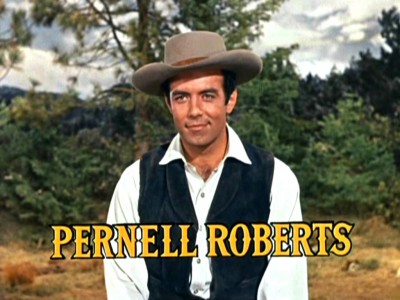
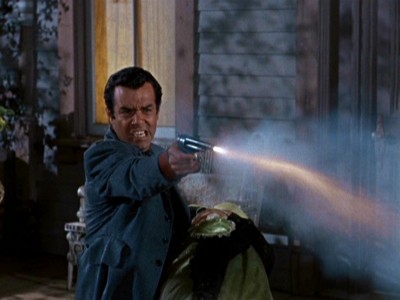
However, romanticism for the land doesn't trump reality; this is also fought-for land - and land still fought over. A constant theme in these first episodes of Bonanza is an outside menace to the Ponderosa. Home and hearth are frequently threatened either by Virginia City opportunists looking to expand their wealth and holdings, or settlers and miners scrabbling for a buck, and coming up against the generous-but-protectionist Cartwrights. Although the Cartwrights increasingly show a willingness to help the citizens of Virginia City as well as anyone who strays on Cartwright land and has a legitimate cause for a request for help - the Cartwrights often refer to themselves as the only stabilizing force in the region - they'll fight to keep what's theirs, regardless of who's trying to do the taking. With their wealth comes responsibility, and they meet it, but the series is smart to occasionally question their lofty positions, too. In several episodes, it's made clear that some citizens and passers-through don't especially cotton to the "high and mighty" Cartwrights, with one such person actively wishing for their comeuppance. More interestingly, in The Newcomers, guest star Inger Stevens has a fascinating exchange with an increasingly unsettled Ben, when she questions his belief that it's right to kill anyone who tries to take from the Ponderosa. Ben starts by stating, "I'll fight for what's mine and what I believe in," even going so far as to say he'll kill a man who believes differently, if he has to. She replies with a discussion of patterns of history, where other men who believed differently still came onto land that wasn't theirs, protected first by the military, and then by forts, until the land became theirs, warning Ben: "Be careful it doesn't happen to you." That an intriguing counter-message to Bonanza's oft-repeated belief in the rightness of the Cartwrights' mission in life, and one that could apply to many of the cultures and beliefs that constantly war in the Bonanza episodes. We'll see if there's more complexity like that to come in future episodes.
Other more familiar "adult Western" stories fill this first half of the first season of Bonanza, such as treatises on lynching parties, or corrupt officials, or the ever-popular "wronged" women with questionable pasts. I was pleasantly surprised at how funny the show could be, as well. After a few serious episodes, one like The Saga of Annie O'Toole pops up out of nowhere, and we're treated to a marvelous little Irish-flavored fable featuring an expert performance by Ida Lupino, and many wonderful throwaway bits like the miner sniffing madly like a dog and yelling, "Woman cooking! Woman cooking!" as he scrambles to discover where the intoxicating aromas are coming from. Certainly any time the terrific, animated Blocker is on, his infectious good-humor shows through. He's also quite good in the more serious episodes, such as his accomplished scenes with Inger Stevens in The Newcomers, or his gentle, assured performance in The Last Hunt, where he helps Little Joe care for a pregnant Shoshone Indian. Less subtle than Blocker's portrayal, Michael Landon's brash Little Joe obviously stole the hearts of young girls who watched the show; when he's required to be dashing, he is (his several fencing scenes are a treat), but some of the heavier stuff eludes him. Apparently Pernell Roberts was unhappy during most of the shooting of Bonanza, and quite frankly, it shows (Roberts would famously leave Bonanza five years into its fourteen-year run, providing one of TV's most spectacular career flame-outs until McLean Stevenson topped him by hightailing it from M*A*S*H). His character - the most loosely defined of the four - has the series' action elements stolen by Hoss, the authority component by Pa, and the romance department by Little Joe. So...what is he supposed to do around the Ponderosa? We'll see in the next four seasons, I would imagine. As for Lorne Greene, how can anyone argue with his magnificently hammy portrayal here? It's precisely what is called for here to anchor the epic-sized narrative thread that runs through the series; anything "smaller" in performance scale would get lost amid the pines and competing brothers. Tilting his head down and mellifluously rumbling like a moosehead of doom, Greene may not be subtle here, but he commands attention in every scene he's in, and that's what a TV star does. How all of these personalities will mesh, and how the various permutations of their relationships will morph, will have to be seen over the course of 13 and a half more seasons of Bonanza.
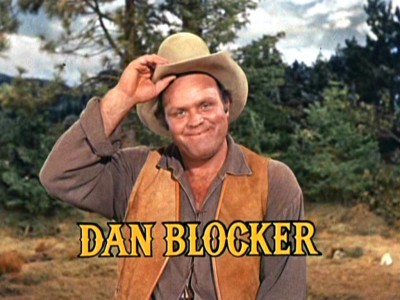
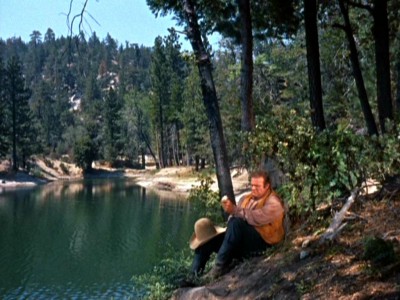
Here are the 16 episodes of the four-disc set, Bonanza The Official First Season: Volume 1, as described on its inside cover. I've listed the bonus material featured on each individual episode here; I'll discuss those and other disc extras below:
DISC 1
A Rose for Lotta (Pilot) (9/12/1959)
Powerful silver barons scheme with famous entertainer Lotta Crabtree (Yvonne De Carlo) to hold Little Joe Cartwright (Michael Landon) hostage in return for Ponderosa timber, vital to mining operations.
Directed by Edward Ludwig. Written by David Dortort.
Special Features: Original NBC Network Peacock logo, bumpers, Lorne Greene RCA promo, and RCA spots, Photo Gallery.
Death on Sun Mountain (9/19/1959)
A greedy opportunist (Barry Sullivan) and his murderous partner (Leo Gordon) slaughter the Paiute nation's wild antelope herds and sell the meat to hungry silver miners at grossly inflated prices.
Directed by Paul Landres. Written by Gene L. Coon and David Dortort.
Special Features: Photo Gallery.
The Newcomers (9/26/1959)
Hoss (Dan Blocker) falls for fragile Emily Pennington (Inger Stevens), who is accompanying her fiancé (John Larch) west, unaware that he intends to introduce hydraulic mining to the Sierras, which will devastate the local environment, including the Ponderosa.
Directed by Christian Nyby. Written by Thomas Thompson.
Special Features: Photo Gallery.
The Paiute War (10/3/1959)
Unscrupulous trader Mike Wilson (Jack Warden) assaults two Bannock women, then shifts the blame to Adam (Pernell Roberts) and an innocent Indian tribe, sparking a needless battle between the Paiutes and the California militia at Pyramid Lake.
Directed by Paul Landres. Written by Gene L. Coon.
Special Features: Episodic Promo, Photo Gallery.
DISC 2
Enter Mark Twain (10/10/1959)
The legendary storyteller (Howard Duff) spins a tall tale that delights readers of the Territorial Enterprise but infuriates the Cartwrights. Ultimately he helps expose a crooked judge (John Litel) and a land grab scheme to takeover the Ponderosa.
Directed by Paul Landres. Written by Harold Shumate.
Special Features: Photo Gallery.
The Julia Bulette Story (10/17/1959)
The owner of "Julia's Palace" (Jane Greer) offers to help fight a fever epidemic despite objections from Virginia City's leading citizens, while Ben (Lorne Greene) objects to Little Joe's infatuation with Julia.
Directed by Christian Nyby. Written by Al C. Ward.
Special Features: Episodic Promo, Photo Gallery.
The Saga of Annie O'Toole (10/24/1959)
When an Irish lass (Ida Lupino) grubstakes her fiancé (Alan Hale, Jr.) to two claims, trouble brews when the miner cannot tell which one he kept and which one he sold to Annie's nemesis, "Trap Door" Gregory Spain (Henry Lascoe).
Directed by Joseph Kane. Written by Thomas Thompson.
Special Features: Photo Gallery.
The Philip Deidesheimer Story (10/31/1959)
Adam helps an engineer (John Beal) who designs a square set system of timbering for the skeptical owner of the Ophir Mine (R.G. Armstrong) and his daughter (Mala Powers); a daring gamble proves the real worth of the costly system.
Directed by Joseph Kane. Written by Thomas Thompson.
Special Features: Photo Gallery.
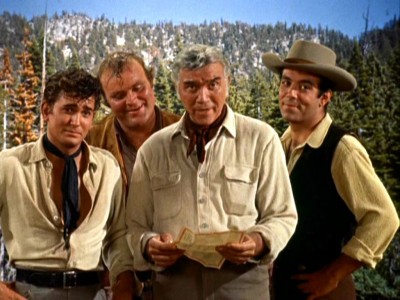
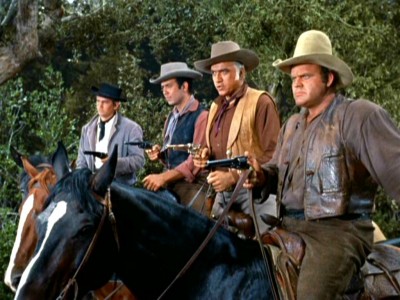
DISC 3
Mr. Henry Comstock 11/7/1959)
The Cartwrights recall the founding of Virginia City, Little Joe's escapades with Paiute Princess Saratuchee (Joanna Sages), and colorful claim-jumper Henry T. P. Comstock (Jack Carson).
Directed by John Brahm. Written by David Dortort.
Special Features: Photo Gallery - including lost sequences.
The Magnificent Adah (11/14/1959)
Adam and his brothers object to their father's romance with Adah Isaacs Menken (Ruth Roman), a daring and flamboyant actress of the Old West ("Mazeppa"); so does her ex-suitor, a ruthless professional boxer (Don McGowan).
Directed by Christian Nyby. Written by Donald S. Sanford.
Special Features: Photo Gallery.
The Truckee Strip (11/21/1959)
A schemer (S. John Launer) uses a crooked ranch foreman (James Coburn) to pit Ben Cartwright against his neighbor Luthor Bishop (Carl Benton Reid) over disputed land, but Luthor's daughter Amy (Adrienne Hayes) falls in love with Joe, who points a gun at Ben in a tense moment.
Directed by Christian Nyby. Written by Herman Groves.
Special Features: Photo Gallery.
The Hanging Posse (11/28/1959)
A grieving husband (Onslow Stevens) forms a posse to track his wife's murderers. Adam and Joe ride along to make sure an instigator (Arthur Hunnicutt) does not turn the posse into a lynch mob.
Directed by Christian Nyby. Written by Carey Wilber.
DISC 4
Vendetta (12/5/1959)
Shot during a bank holdup, Ben mortally wounds a robber. Bedridden, Ben counts on boastful townspeople for protection, but when the vengeful outlaw (Mort Mills) and his gang head towards Virginia City, only Hoss and a former prosecutor, now a town drunk (Simon Scott) stand ready to help.
Directed by Joseph Kane. Written by Robert E. Thompson.
The Sisters (12/12/1959)
Over his father's objection, Adam romances a saloon girl (Fay Spain), whose other admirers include a sheriff (Buddy Ebsen), a town drunk (Malcolm Atterbury), and a gambler (John Stephenson) who challenges Adam to a pistol duel.
Directed by Christian Nyby. Written by Carey Wilber.
Special Features: Episodic Promo, Photo Gallery.
The Last Hunt (12/19/1959)
Hoss and Little Joe help a pregnant Shoshone (Chana Eden) alone in the winter wilderness. They bring her and her newborn to the Ponderosa, and learn the truth about the baby's father (Steve Terell).
Directed by Christian Nyby. Written by Donald S. Sanford.
Special Features: Photo Gallery.
El Toro Grande (1/2/1960)
During a trip to purchase a prized seed bull, Hoss wrestles a bear, Little Joe romances a betrothed senorita (BarBara Luna) and fights a rapier duel with her fiancée (Armand Alzamora).
Directed by Christian Nyby. Written by John Tucker Battle.
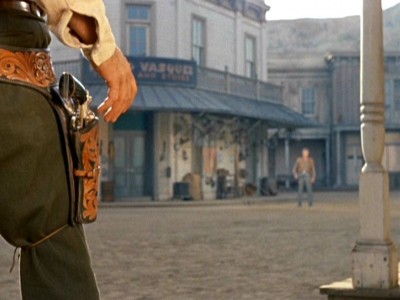
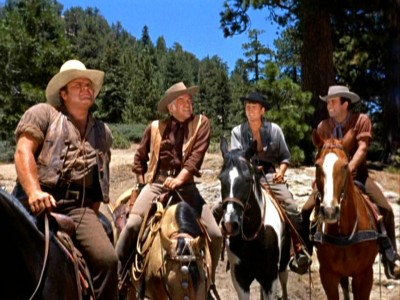
The DVDs
The Video
Normally, with any vintage television release from Paramount, there's an indication somewhere on the back of the DVD cover stating these episodes may be altered from their original network showing. I don't see that warning anywhere on this disc. In fact, Paramount has made a point of stating at the very top that these are "Full-length episodes with Original Music." Well...are they? I'm not a Bonanza expert, but they appear to be complete, with 49 minute-and-change run times that would be in line for the original run network run times (minus bumpers, network logos and promos). And if music was substituted, I couldn't tell. So...I'm going with Paramount on this one and leaving any detective work to the experts on the series (some of whom, no doubt, will obsess over two-second cuts of music cues if given the chance). As for the video image itself - it's damn good. I haven't seen Bonanza in a couple of years, but I remember the prints I saw as quite faded and red-tinged. Not so here. All of the materials used here look spiffed up, with brilliant color and only minor screen anomalies present (some dirt and scratches do show up now and then). Episodes are kept four to a single-sided disc, so compression issues are negligible, at best. Grain is a factor, but that's to be expected in the original materials utilized here. I would imagine this is the best Bonanza has ever looked, even when it was originally broadcast (because those first color TVs can't compare with what we have today...if you could even get a sharp picture with your aerial). A solid, impressive presentation for a series that needed it.
The Audio
The Dolby Digital English split mono approximates the original network broadcasts, and it's been recorded at a surprisingly hefty level - those gunshots sound fat and healthy. All dialogue is crisply rendered, and hiss, although noticeable, is not at all distracting. Close-captioning is available for all episodes.
The Extras
Let's hope the extras included here don't end with Season 1. As I listed above, most episodes on this set have additional bonuses in the episode's menu - usually a photo gallery with numerous behind-the-scenes production shots pertaining to that episode. While I'm not usually a big fan of photo galleries, these are informative (we get to see lots of "off-camera" moments) and fun (many shots of the actors having an obvious ball shooting the series). Some episodes have as many as twenty stills or more in their respective gallery - not bad at all. In addition, a few episodes have their original episodic promo you can access (see above for titles). They're in rough condition (very pink), but it's amazing they even survived. The first episode, A Rose for Lotta, also has a sweet original NBC Network Peacock logo spot, bumpers for the commercial breaks, a spot with Lorne Greene saluting the audience for watching the first Bonanza, and a spot for NBC.
Each disc has a separate bonus selection, as well. On disc one, an episode of Fireside Theatre, entitled Man of the Comstock, is included here. Written in 1953 by Bonanza's creator, David Dortort, Dortort states this story was "the genesis of Bonanza." It stars Bruce Bennett, Andrea King, and Jonathan Hale, and it runs 24:47 (and it looks phenomenal in creamy black and white). Next, from a series of interviews from 2002 with creator Dortort, we get this snippet, The Ponderosa Map Story, where he details the commisioning of the map...and the little trick they employed to fix its inaccuracies. It runs 2:17. Next, we get the rare, notorious Alternate Pilot Ending Featuring the "Singing Cartwrights", a moment captured in time that might have ended the series before it started, had it been included in the first telecast (it's...hilarious). And finally, three photo galleries - NBC Headquarters, Clarence "Fat" Jones Stables (where the cast learned how to ride), and Publicity Stills - round out the extras with an additional 94 stills, combined. On disc two, there's a photo gallery for Bonanza World Premiere in Reno, Nevada, August 22-23, 1959, which features 21 fascinating stills from "Color Television Week" in Nevada, declared by then-governor, Rex Bell (do they still celebrate that there? Because if they do - I'm going). Great candid shots of the stars promoting the series. On disc three, more of the 2002 filmed interview with Bonanza creator, David Dortort. Here in Remembering Michael Landon, Dortort recounts his hiring of Landon for the part of Little Joe. It runs 2:32. Next, there's a photo gallery for Lake Tahoe Location - June 1959, featuring 11 stills from location shooting. And finally, Credit Drawings: Joe Messerli's Early Concepts features one card showing early attempts at fashioning those beautiful paintings that run under the final credits of the Bonanza episodes. On disc four, the final snippet of Dortort's interview, Remembering Dan Blocker is included. It runs a brief 5:20.
Final Thoughts
You can't say you've watched TV if you haven't seen at least one episode of Bonanza. It's that much a part of television history and 1960s popular culture. An argument could be made that the phenomenal success of NBC's Bonanza single-handedly pulled the other two networks into color transmission, thereby advancing the entire industry. But icons sometimes don't feed the bulldog if they can't translate out of their specific time and place (ever watch an episode of Hill Street Blues lately? Yikes.). Fifty (!) years later, though, Bonanza still works, with an epic-sized look and reach, an attention to more complex themes and storylines in the advancing "adult Western" genre, and a varied central cast that pinch-hits for just about any fantasy figure you may want to identify with in the Western genre. And this is just the first season of the 13 & 1/2-year hit. I would have liked to see an overall documentary on the series, or even a text pamplet with a brief history, for the bonus section (Paramount...you know you can call me anytime), but still - bonuses are bonuses, and for the most part, they're quite interesting. I highly, highly recommend Bonanza: The Official First Season, Volume 1.
Paul Mavis is an internationally published film and television historian, a member of the Online Film Critics Society, and the author of The Espionage Filmography.


|
| Popular Reviews |
| Sponsored Links |
|
|
| Sponsored Links |
|
|
| Release List | Reviews | Shop | Newsletter | Forum | DVD Giveaways | Blu-Ray | Advertise |
|
Copyright 2024 DVDTalk.com All Rights Reserved. Legal Info, Privacy Policy, Terms of Use,
Manage Preferences,
Your Privacy Choices | |||||||














